Bonampak “Painted Walls”

- Bonampak is a small site with Medium sized pyramids and temples. It’s claim to fame is the Temple of Murals with three rooms that house world famous murals.
Named in Yucatan Maya after the beautiful world famous murals in structure 1 – The Temple of Murals
HISTORICAL NOTES
Bonampak was a never a major city or powerhouse in the Mayan world. Bonampak, Yaxchilán, Piedras Negras and Palenque used the Usumacinta River bound for commerce and trade and at the same time competed for territory and dominance.
K’inich Tatb’u Skull I, leader of Yaxchilán, a Mayan city -30 kms to the North, defeated Bird Jaguar of Bonampak in 400 AD. Later many nobles were captured and eventually in 514 Yaxchilan’s leader Knot-eye Jaguar I was captured and taken to the city of Piedras Negras in Guatemala. In 526 Bonampak was attacked again and more nobles were captured.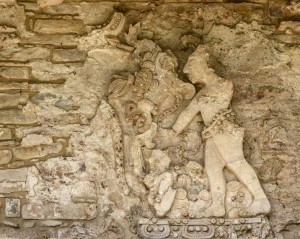
Bonampak became a satellite community and was governed by Yaxchilan. The Yaxchilán ajaw, king/leader Itzamnaaj B’alam II (Shield Jaguar) appointed his nephew Chan Muwaan II to govern the community in 790 AD. Chan Muwan was married a princess / noblewoman from Yaxchilán. Shield Jaguar hired Yaxchilán artisans to construct the Temple of Murals. Most of the monuments at the site today were created under Chan Muwan’s rule are physically oriented towards Yaxchilán.
Bonampak is famous for the Temple of Murals with three rooms that house the world famous murals. The turquoise, yellows and rust colors are bright and clear depicting royal life. No other painting or mural from that time gives as much information. The vivid colored frescos give Bonampak its name: Painted Walls. Beyond this particular city, the murals give archeologists solid information and detail about Mayan life and beliefs.
-
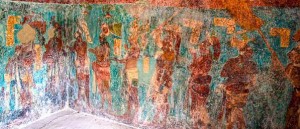
- Bonampak The turquoise, rust and yellows are bright and clear as you duck into the 3 chambers on top of the temple.
Bonampak was rediscovered in February 1946. John Bourne, heir to the Singer sewing-machine fortune and Charles Frey, a young WWII conscientious objector were led by Chan Bor, a Lacandon to the site. The site was still a place of worship for the Lacandón Indians who still prayed at the temples and no other outsider had ever seen these temples. That same year Chan Bor led American photographer Giles Healey to the Temple of Murals.
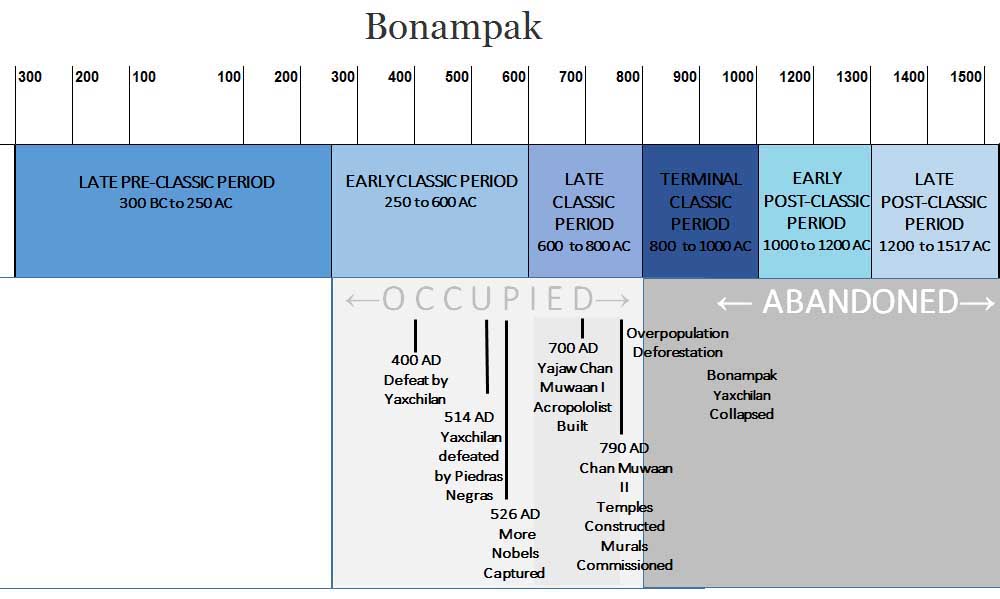
DATES
Occupation
Early Classic Period 250 BC
400 AD defeated by Yaxchilan
514 AD Yaxchilan suffered a defeat to Piedras Negras – a Guatemalan city to the North
526 AD More nobles attacked and captured
Peak
700 AD Yajaw Chan Muwaan I appointed as lord in Bonampak. Reoriented building to orient towards Yaxcilan. Acroplolis built.
790 AD Chan Muwaan II appointed to govern, Temples constructed, Yaxchilan artists commissioned for murals
800 AD Murals completed. Region was suffering from overpopulation, deforestation and exhausted farmland. Bonampak collapsed with Yaxchilán.
LOCATION & DESCRIPTION
Geographic location
Location – In the Lacandon jungle on Usumacinta River in Chiapas Mexico, the Bonampak site abuts the Reserva de la Biosfera Montes Azules. It is 30 KMs south of Yaxchilán or 148KMs from Palenque.
The land is relatively flat with dense jungle vegetation.
The site is approximately 2.4 square kilometers. Currently visitors are restricted to viewing the main ruins at the Gran Plaza. The Acropolis to the south of the plaza, houses the murals.
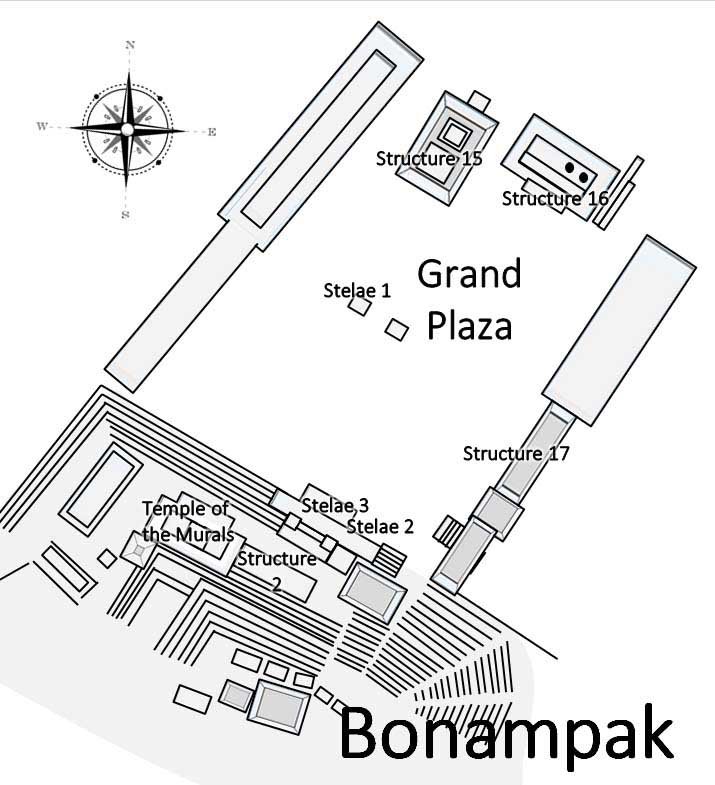
The Entrance
At the entrance gate to the park you will find rest rooms, parking and refreshments. You are charged and entrance fee to the park and a ruins fee. Free on Sundays for nationals and Mexican residents.
The entrance is approximately 8 kms (5 miles) on a gravel road to the ruins so it is necessary to take a bus or taxi. You can also rent a bike.
Major Groupings & Descriptions
The Gran Plaza

The Gran Plaza measures 110 meters long and 87 meters wide and is surrounded by various platforms and structures. It is oriented towards Yaxchilán. In the center of the rectangle are two stelae under palapa canopies to protect them from the elements.
At the far southern end is the Acropolis is fitted into the hillside with the famous Temple of Murals on the top of the platform.
Stelae 1
5.06 meters (16.6 feet) high by 2.60 meters (8.5 feet), and 50 cm (20 inches) thick.
The stelae commemorates the ruler ship of Chan Muwaan II at the peak of his reign. Su cara está labrada y mira a la acrópolis; en ella se representa al señor Chaan Muan II vestido con lujosos ropajes y un alto tocado. II He is holding a ceremonial spear in his right hand and a shield in his left. The shield has the face of the jaguar God of the underworld. The ruler wears a tall headdress and plush robes.
The glyphs name his parents and himself. You can also see the cave monster of the underworld.
Read more about the meaning and importance of Stelae
Stela 2
Chan Muwaan II is engaged in a bloodletting ceremony with his mother and his wife. His mother holds a bowl filled with paper to collect the let blood. Muwaan’s wife is on the other side holding needle (sea Urchin Spine) to perform the ceremony.
It was a ruler’s duty to perform bloodletting and other self-mutilations to demonstrate their divine relationship with the Gods and universe.
Stela 3
Chan Muwaan II appears with captives before him.
The Temple of the Murals
After climbing the stairs to the right of the superstructure known as the Acropolis, you will see the Temple of the Murals, They are three separate rooms with separate entrances. Each room has a different story.
The paintings are frescoes; paintings made on wet plaster. Each room was painted in a single session as there are no seams in the painting and the painting is completed while the plaster is still moist. The technique involved a 3 part process where a red outline was made over a fresh coat of stucco. These were then painted colors of blue, red, yellow, sepia, mauve, purple and green using natural pigments from minerals and plants. Then a black outline was painted to outline and give the figures definition.
These are the finest known murals of pre-Hispanic cultures. The murals help archeologists understand the beliefs and rituals of the ruling elite. Included are depictions of human sacrifice, war and the consecration of a ruler.
Musical Instruments, costumes, weapons are documented from the period giving valuable information about the Mayan culture.
Unfortunately the murals have deteriorated badly since their discovery. Early archeologists from the Carnegie Institution doused them in kerosene to remove grime and “bring out their colors.” And consequently weakened the plaster so much that the paint and plaster began to flake and fall off.
Professor Mary Miller of Yale, who studied the murals extensively wrote “Perhaps no single artifact from the ancient New World offers as complex a view of pre-Hispanic society as do the Bonampak paintings. No other work features so many Maya engaged in the life of the court and rendered in such great detail, making the Bonampak murals an unparalleled resource for understanding ancient society.”
No more than four visitors are allowed in a single room at a time. No flash as it deteriorates the colors.
Mural 1
Mural 1 depicts the Chan Muwaan II and his wife Lady Rabbit’s presentation of the Governor’s son before the elite court: The consecration of the Devine Ruler’s Heir.
Nobel’s and servers prepare for the event. Witnessing the ceremony are noblemen and priests while and orchestra plays trumpets, drums and various other instruments: Other nobles confer about the event.
Mural 2
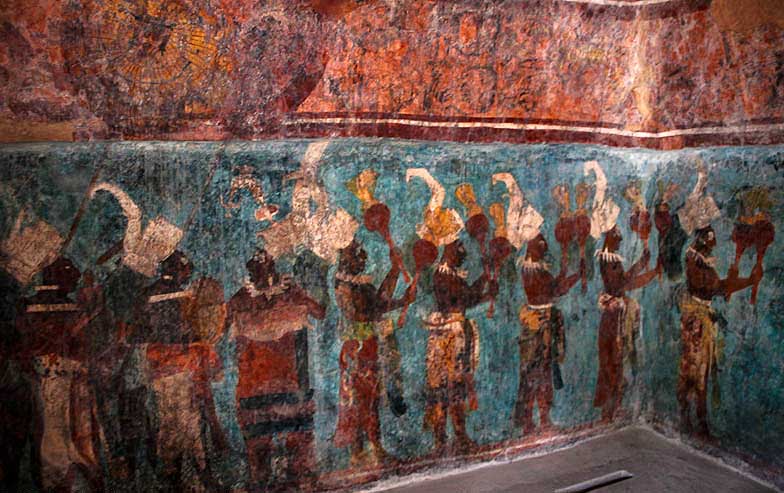
Room 2’s mural depicts war and the conquering of the enemy. Captives are tortured by having their fingernails removed. Chan Muwaan II battled dressed in a jaguar skin presides over the torture. Beside the captive is a severed head presumably of a previous sacrificial victim.
Ancient Mayans, like the Aztec and Toltecs, battled over territory and trade. They preferred to capture rather than kill their enemy and then sacrifice the captives to the Gods before the general public.
This mural shattered the long held theory that the Maya were peaceful until the Toltec arrived from central Mexico. The murals predate the arrival of the Toltecs and demonstrate the warlike nature of the Mayans through battle, capture of the enemy, torture and sacrifice.

Mural 3
Room 3 shows the victory celebration on the Acropolis steps. Dancers in fine costumes wear masks of Gods. Lords wear huge headdresses. The ruler and his family puncture their tongues in a ritual bloodletting.
The sacrifices and bloodletting and celebration may have been prompted by the new heir to the throne.
HOURS
Open Daily from 8 am to 4:45 pm.
Admission 2013 48 pesos. Free on Sundays for nationals and Mexican residents.
Allow at least 1 to 2 hours, especially if you like to take photographs, read each plaque and climb each structure.
RECOMMENDATIONS
As this is site is in a remote jungle area, take water and insect repellant. Wear comfortable walking shoes with a non-slip soles as there is walking and some climbing to see the murals.
Wear light clothes and cover up to avoid mosquitoes. A sunglasses and a hat are advisable. Also give considerations to the weather at the time of your visit and dress according to the season you are visiting. It rains here frequently.
We recommend you stay on the designated paths as you can easily get lost in the dense bush jungle.
Consider taking a daypack with snacks and water. Hydrate constantly. Bring a camera with extra batteries and memory. There are no vendors to purchase more.
You are likely to spend 1 to 2 hours at this site.
GETTING THERE
GPS –N 16.42.14 W 91.03.54
Bus
You can take a public bus from Palenque however the stop is 3kms (2 miles) away from the site entrance. You can then take a local bus to the site entrance. While this is the least expensive option is also more difficult and take more time.
Tours
From Palenque a popular tour is bus to Bonampak and Yaxchilán. The cost for this is approximately 700 pesos both ways. This includes the 2 admissions, parking, bus transport, community fee, boat transport and food.
Driving from Palenque:
You can easily drive your vehicle to Bonampak and Migration at the boat launch to Guatemala and Yaxchilán.
Drive from Mexico Highway 199 South from Palenque to the Junction of Mexico Highway 307 and 199. Go to the 307 and drive 123 kms and make a slight right to Carretera Fronteriza del Sur and drive 100 meters. Take 1st right onto Carretera Fronteriza del Sur and drive 4.2 kms. Turn Left and drive 8.8 kms to Bonampak.
It takes approximately 2.5 to 3 hours to drive from Palenque to Bonampak.
You will pass as many as 3 military checkpoints that generally waive you on southbound and check more vigorously going north.
(If you go on to Tikal you must check out of Mexico with Migration on the Mexican side at the boat launch which requires your FMT, FM2or FM3 and passport.)
There are no gas stations.
Make sure you have plenty of time as it is never advisable to drive at night in Mexico
The roads in the past were not considered safe. This has changed somewhat and improved with the military presence.
